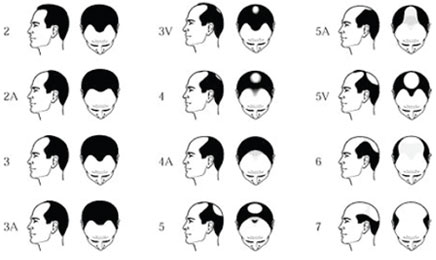MALE HAIR LOSS
Types of Hair Loss
Although there are different causes of thinning hair in men, about 95 percent is due to male pattern hair loss, the symptoms of which include a receding hairline and/or thinning at the crown of the head. The remaining five percent of hair loss in men can be due to an underlying health conditions like autoimmune disease, hormone imbalance, severe trauma or medication side effects.
Male Pattern Hair Loss
The most common cause of hair thinning in men, male pattern hair loss is inherited from one's parents. This type of hair loss is due to the effects of DHT, a byproduct of testosterone that causes hair follicles to stop producing normal hair and start producing thin, short, colorless hair before eventually ceasing hair production altogether. Thinning hair is the first symptom, but this can quickly progress to bald spots, and once the follicles atrophy, the scalp appears tight and shiny.

Alopecia Areata
Presents as patchy hair loss on the scalp and in the beard area. As the hair falls out, smooth, round patches the size of a coin or larger become visible. This type of hair loss occurs in children and adults, and is caused by the immune system attacking the hair follicles. Alopecia areata can start and stop suddenly.
Telogen Effluvium
Caused by anemia, low iron, inadequate protein, thyroid disease, surgery or illness, telogen effluvium presents as massive hair shedding over the entire scalp. Among the first symptoms of telogen effluvium is losing large amounts of hair in one's hairbrush, in the shower or on one's pillow. Once the root cause is treated, this type of hair loss generally reverses in six to 12 months without the need for further treatment.
Traction Alopecia
This type of hair loss is the result of excessive strain on the hair follicles. Most commonly caused by braiding, ongoing pulling permanently damages the follicles and prevents hair from regrowing.


